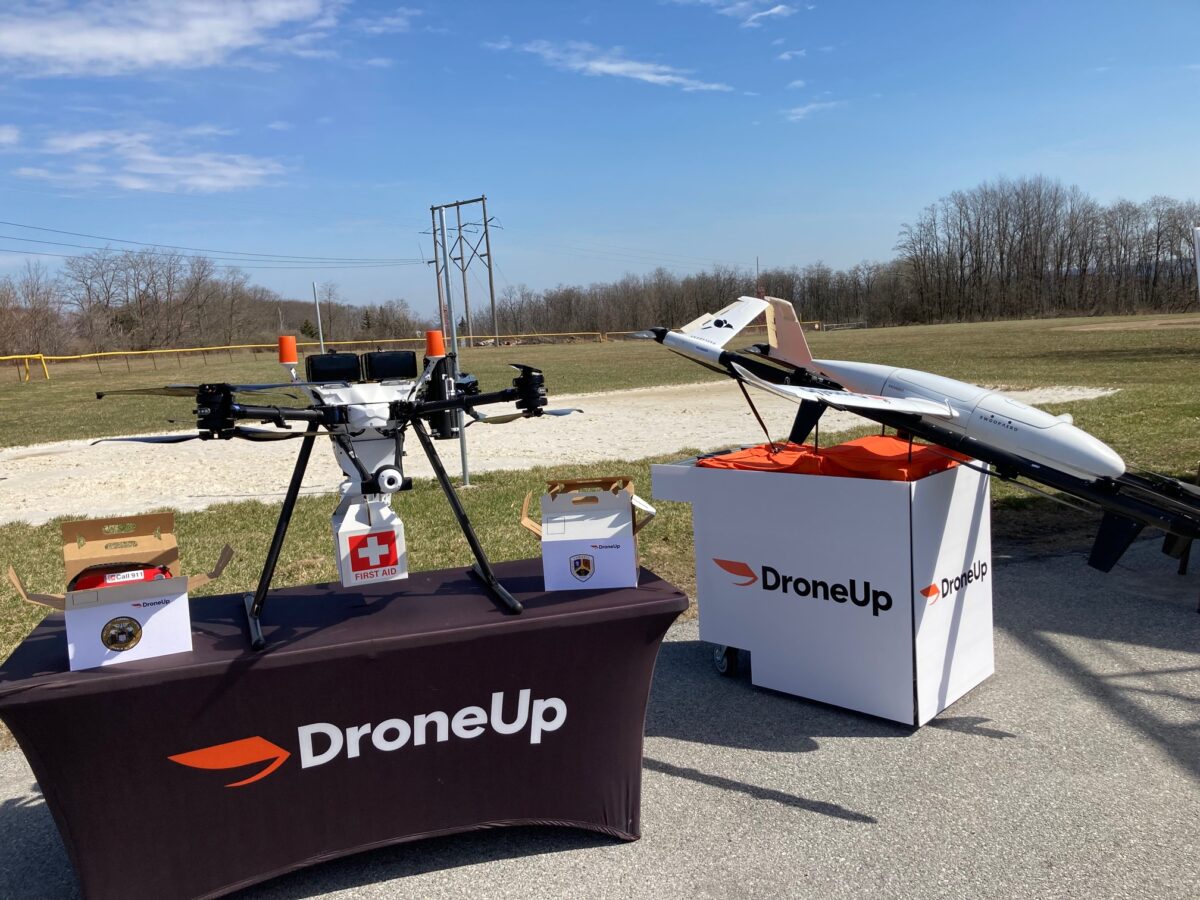What started out as a path to provide more jobs and educational opportunities in the aviation field in the Johnstown area has morphed into a nationally innovative way to deliver emergency medical care using drones.
Through a collaboration of aviation leaders and first responders coordinated by the Southern Alleghenies Planning and Development Commission, officials will set up a pilot project to deliver life-saving treatment such as Narcan for opioid overdoses or an AED for heart attack victims by drone before an ambulance or other first responders can arrive. That can be extremely important in mountainous, rural areas of Cambria and nearby counties that have seen a substantial drop in ambulance and EMS services in the past 50 years.
They hope to begin using the system within six months through the help of a $1.92 million U.S. Department of Transportation grant announced Thursday at a news conference at Solomon Run Volunteer Fire Co. Station 3 near Johnstown. Robert C. Hampshire, the department’s deputy assistant secretary for research and technology and its chief science officer, used the Cambria County event to highlight 34 grants worth more than $50 million awarded across the country for transportation projects that use innovative technology.
The Cambria County program meets all the goals in the Biden administration’s Strengthening Mobility and Revolutionizing Transportation grants program by using technology to reach underserved areas, creating educational opportunities and jobs, and improving safety through quicker delivery of life-saving services, Hampshire said.
“We’re looking for this region to serve as a model for this state and this country to learn from,” he said. “This grant really encapsulates the goals of the program to use transportation to save lives.”

How it will work
The coalition will use the federal grant money to set up 50 sensors in the demonstration area in the southern part of the county, buy a fleet of drones and medical supplies, and establish a series of launch sites. The drones likely will be supplied by DroneUp, a Virginia Beach, Virginia, company that has worked with Walmart and others with drone delivery programs.
Those sensors will be highly programmed to identify anything that could be in the way of a drone from trees, buildings, utility poles and wires to airplanes and helicopters. The sensors will interact with the FAA’s tracking systems, and the drones can respond in 200ths of a millisecond to maneuver out of the way of other aircraft, according to John Eberhardt, managing director of system consultant ATA Aviation of Fredericksburg, Virginia.
When someone calls 911 to report a heart attack or drug overdose, the dispatcher instantly enters the address and code that dispatches an ambulance/EMS crew and the nearest drone at the same time. Eberhardt said it hasn’t been determined whether drones will be preloaded with Narcan or an automated defibrillator or instantly pick up the load at the launch site.
With the delivery address already programmed in, the drone can travel as fast as 2 miles in three minutes at a height of about 200 feet. When it arrives at the site, it drops to about 80 feet and uses a winch to lower its payload in a box with the universal Red Cross symbolizing medical equipment.
The expectation is that the drone regularly would arrive before emergency personnel and people on the scene can begin treating the patient immediately. Greg James, vice president of business development for DroneUp, said studies have shown the chance for survival goes down 20% for each minute treatment is delayed.
Where it started
This program had its start just over three years ago when several disparate elements came together.
Art Martynuska, the county’s emergency management coordinator and 911 director, said some colleagues had an interest in drones and they were talking about how they could help with public safety.
About the same time, Larry J. Nulton, chairman of not-for-profit aviation career advocate Aerium, was looking for ways to expand aviation opportunities in the area. He initially talked with St. Francis University to set up a flight school there and with county officials about a maintenance program at Johnstown-Cambria County Airport.
That led to additional discussions about repurposing the airport, the potential use of drones and a partnership with the University of Alaska. The medical delivery program would be the first to come out of that collaboration, an innovative community-beneficial way to kick-start the educational component.
“We recognized early on that securing funding and approval for this innovative airway project would be a significant undertaking,” Nulton said in a text interview. “However, the potential benefits for Pennsylvania’s educational system, particularly for high schools and postsecondary institutions, became a driving force for us. The project underscores the importance of integrating emerging technologies into our educational curriculum, aiming to position Pennsylvania as a leader in aerial mobility training and application.”
Hampshire said DOT was impressed with the combined effort and selected the Cambria project as one of 34 to get funding out of 320 applications. This is just the first phase of the grant program to demonstrate whether the projects will work as intended, and the agency has $500 million available over five years to expand them.
“They already had many of these elements in place and ready to go,” he said. “We’re just kicking in to accelerate it.”
Eberhardt said the expectation is that once the system is established, medical insurance will cover operating costs of the drone system. Officials here already are talking with neighbors in Somerset and Indiana counties about participating if the program expands.
What could be next
Cambria County officials are counting on becoming a national leader in drone technology and the expansion of aviation-related training and industry to spur a local economy still reeling from the collapse of the steel industry.
“The future is the practical application of drones,” said state Rep. Frank Burns, D-Johnstown. “We’re doing that right here in Cambria County. Cambria County is on the cutting edge.”
Scott Hunt, chairman of the county board of commissioners, called the program “a game-changer,” and Commissioner Thomas C. Chernisky said the medical delivery program is “just a start.”
“We can get to remote areas and reach the underserved,” Chernisky said. “We don’t even know [everything] we can do here yet.”
Officials envision using drones to assess fire scenes before firefighters arrive as well as potential commercial uses, plus the jobs that would go with operating and repairing equipment.
Eberhardt, who works with other drone programs across the country, said similar projects for medical services are under development in Cleveland, Virginia and California. Now, the local program is as the head of the pack.
“Cambria County just took a big leap forward,” he said.
Ed covers transportation at the Pittsburgh Post-Gazette, but he's currently on strike. Email him at eblazina@unionprogress.com.



